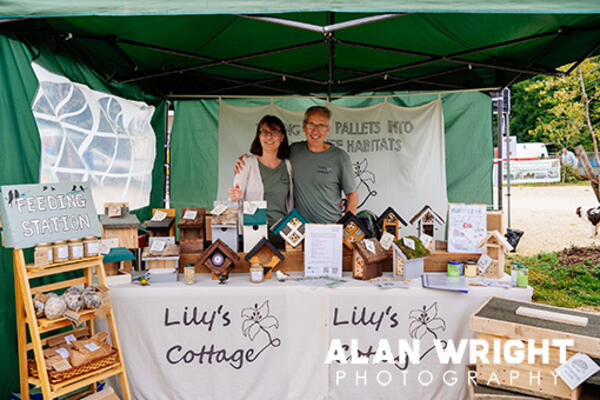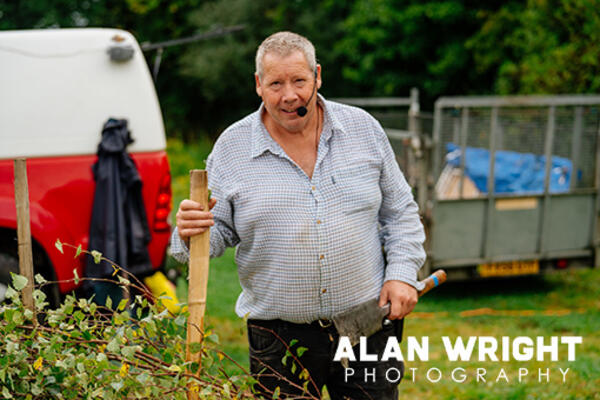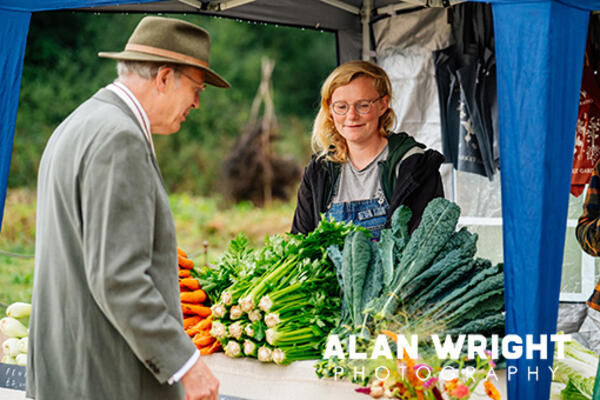CRPE COUNTRYSIDE DAY AT KNEPP

Published on 1st October 2024
The second annual CPRE Sussex Countryside Day was held at the Knepp Estate, Dial Post, on 7 September.
The event gave visitors an opportunity to learn about efforts to protect, restore and celebrate the Sussex countryside. There were guided talks and tours on forest bathing, foraging and reconnecting ancient woodlands, as well as nature-themed activities for children by Nature Makers and Horsham-based CIC Woods for Learning. There were also stalls from charities and organisations including the Campaign to Protect Rural England (CPRE) and the Gatwick Area Conservation Campaign.
Many took the chance to learn about wildlife conservation from the Sussex Wildlife Trust, the RSPB and the Weald to Waves project, which aims to establish a 100-mile wildlife corridor from the Ashdown Forest to the Sussex coast. The rewilding project at Knepp is key to its success, as it helps to connect the county’s rivers and wetlands.
While Knepp’s rewilding project has rejuvenated the fortunes of several species (it is a stronghold for turtle doves and purple emperor butterflies), it’s the white stork that has come to symbolise the success of the estate. Many visitors walk Knepp’s trails in the hope of seeing the striking bird, and children in particular were keen to learn about them from wildlife experts at the Countryside Day.
Laura Vaughan-Hirsch of the White Stork Project said: ‘There were no storks in the UK for 600 years until we launched this project four years ago. This year, 29 chicks fledged from 11 nests across the estate, so it’s been an amazing success. As the estate isn’t used for agriculture, there are no herbicides and pesticides and this ensures that earthworms, insects and other small invertebrates thrive. The storks love to forage here as it provides them with everything they need.’
‘When we started the White Stork Project, we wondered if the birds would know how to migrate after six centuries. Amazingly, that instinct has remained. We track as many storks as possible and this year fitted nine with tracking devices. The storks are now on their annual migration, travelling as far as Morocco, and will return to the colony to breed early next year. While they currently only nest at Knepp, we hope they will spread out across Sussex and beyond in the coming years as the project expands.’
‘The storks have become a story of hope. They have a long association with Sussex, even appearing on the Storrington village crest as they once nested in the wetlands there. In time, we hope the storks spread into areas where they were once abundant, as that will be very special.’

ANIMAL HOUSE
The interest in the natural world amongst the attendees presented a chance for small businesses and enterprises to promote related products. Martin and Debbie Standen run Lily’s Cottage, named after their dog. They use old wooden pallets to build wildlife habitats including bird boxes and hedgehog houses.
Debbie said: ‘We made a bug house from a pallet and stuffed it with bamboo, twigs, pine cones and bark foraged on our daily dog walk. We put it in our garden and some of our friends and relatives asked us to make one for them too. Lily’s Cottage has grown from there. We now make a range of habitats at an affordable price to encourage wildlife. We also re-use glass jars, filling them with our own feed to encourage small birds to forage. We’ve also made planters and compost bins, as well as Pollination Education Stations (PES) for Sussex Green Living. These have been installed at schools and businesses, encouraging insects and inspiring people to get involved in conservation.’
Sussex Green Living were also at the Countryside Day with the Inspiration Eco Station, a converted milk float that helps the charity promote environmentally-friendly or sustainable ideas. SGL sells recycled products too, including hats made in the Philippines.
Carrie Cort, Founder and CEO of Sussex Green Living, said: ‘In 2012, I was concerned about the number of crisp packets going to landfill, as they couldn’t be recycled. At that point, we didn’t have TerraCycle schemes, so I searched for alternatives and came across the Purple Community Fund, an organisation that works with deprived communities in Manila. One of their initiatives is turning used crisp packets, ring pulls, toothpaste tubes and other items into clothing and accessories, such as hats and bags. Some of these are sold in boutique stores, but we sell them for a suggested donation of £40, which goes back to the Purple Community Fund. They’re beautiful, hand-made hats, but of course they’re very quirky, so while most people love them, finding a buyer can be a challenge!’

PIRATE SPIRIT
There was a range of Sussex-based food and drink produce too. Goldstone Rum, based in Henfield, offered samples of its award -winning rum. The most potent is Sussex Overproof, which won a Special Gold Commendation at the 2024 People’s Choice Spirits Award.
Georgina Bowell said: ‘If you take rum from 40% to over 50%, you get a very different flavour and a distinct aroma. Our Overproof is 57%, which really brings out the flavour of the three types of cane sugar we use. The term Overproof is derived from pirates, who would test the content of rum by setting it alight. That aside, we veer away from Caribbean connotations and promote the brand as part of the growing food and drink movement in Sussex.’
Fresh fruit and vegetables were on offer too, direct from the Market Garden at Knepp. Established in 2022, the garden provides fresh produce to the Wilding Kitchen and farm shop. Rosanna Catterall said: ‘We have formed a strong connection with the chefs and now, if we have fresh vegetables or an abundance of something in particular, they will create a dish that utilises it. We love tomatoes and grow a wide variety. Brad’s atomic grape, named after the head chef, is high in tyramine and has gone down very well at tomato tasting events!’
Rural trades and skills were on display too. Bulchins Farm, a Wisborough Green-based business specialising in livery, breaking and rest and recuperation, proved popular with young visitors, with children treating the animals to fresh carrots from the market garden. Phil Hart demonstrated hedge-laying techniques, using traditional tools such as a billhook. Phil highlighted different hedge styles adopted across the country and showed how they can create natural, carbon-rich borders while also providing a safe haven for wildlife.
Phil said: ‘My work mostly comes from local authorities or farmers needing to manage hedge rows. At Knepp, they’re rewilding the estate naturally, which is a great thing. Hedges are vital as they provide a safe habitat for everything from moles, voles and hedgehogs to birds, including robins and blue tits. Skilled hedge-layers can create several stems to encourage regrowth and restrict access under hedges, while there are also ways to create multiple layers to provide thick foliage for birds.’
It is hoped that the CPRE Sussex Countryside Day can in future become part of a nationwide celebration of everything great about the countryside. CPRE Sussex director Paul Steedman said: ‘It was fantastic to see how passionate people are about the amazing spaces we have on our doorstep, and the need to protect them from future threats. Thanks to everyone who came along, the talk leaders and stall holders, and the Knepp Estate for hosting us at the home of Sussex rewilding.’
WORDS: Ben Morris
PHOTOS: Alan Wright
Further information:
Visit the website at www.cpresussex.org.uk


